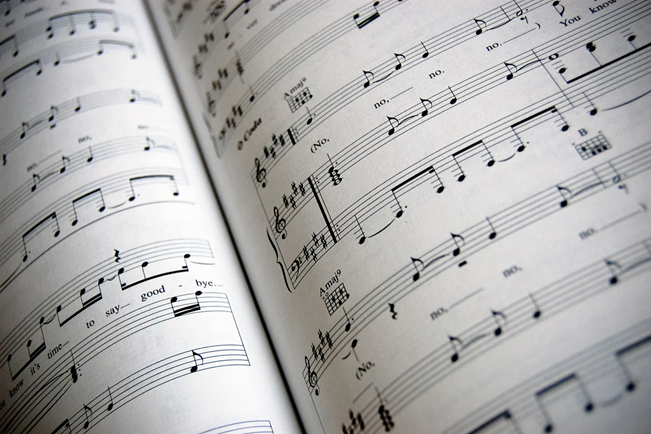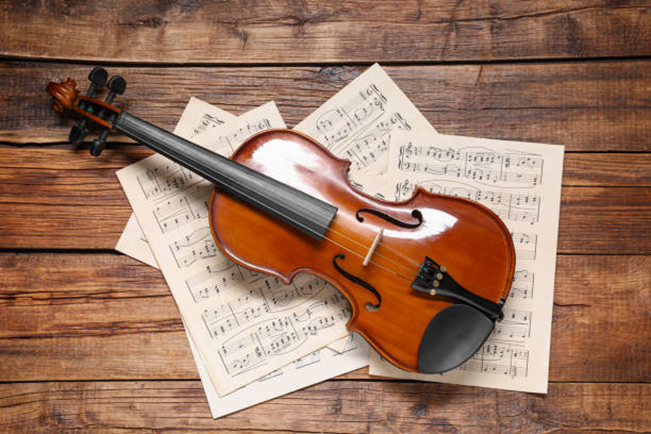Known for its captivating sound, the violin has a rich musical tradition inspiring musicians all over the world. In the depths of mastering the instrument is the ability to read and interpret violin sheets as a universal music language.
Whether you’re reading sheet music for learning a new piece, performing with others, or working on your musical skills as a beginner, reading sheet music is an essential skill for every violinist.
Violin Sheets vs. Tabs: What’s the Difference?

For any aspiring violinist, understanding the difference between violin sheet music and tabs is essential. You will find both kinds of notation useful for their different purposes and advantages.
What Is Violin Sheet Music?
Sheet music in general is the standard notation system used for most instruments. For violins, sheet music is written in standard notation, a five-line staff with the treble clef representing musical notes, dynamics, rhythm, and articulation. This way, notation, as we know, gives information on all aspects of a note: which note and how long to play it, how loud or soft it should sound, and how to express it correctly.
It is safe to say that the universal language for you as a musician is a well-curated and easily readable violin sheet, and it builds the connection between you and your instrument. Learning such a system takes time and practice, but it creates a solid foundation of music theory and sight-reading over the years.
What Are Violin Tabs?
Violin tabs are the perfect tool for beginners. They plainly show where your fingers have to rest on the string to give you a note, rather than having you deal with traditional music notation. Instead of using notes on the five-line staff, tabs lay out the strings from bottom to top, G, D, A, E, and use numbers as a guide to place which finger goes where. This speeds up the learning process without much sense of rhythm, notes, harmony, and meter of music.
However, you should know that tabs come with limitations. You do not get information on how long to hold each note and how loud it needs to be. That is why it is just a temporary solution. Knowing how to read and sing from standard notation is a key factor in becoming a violinist.
Which Should You Use?
So, which one should you go for? As a beginner, start with tabs as they are fairly easy and will get you into playing quickly. As you become more serious about your violin, mastering reading sheet music will additionally improve your skills.
Basics of Reading Violin Sheet Music
Reading a violin sheet is a must-have skill for any violinist. It allows you to dive into the world of music with expressive, accurate playing. Here are the basics of every violin sheet of music.
The Staff and Treble Clef
Violin notes are written on a staff of five horizontal lines in the treble clef. Every line and space represents a note, with pitch increasing as you move from the bottom to the top. This visual layout helps you understand which pitch to play and where to place your fingers. After you get familiar with the staff and the treble clef, you will read music with accuracy and confidence.
Notes and Open Strings
The open strings of a violin, G, D, A, and E, are arranged from lowest to highest in pitch and build the grounds for violin music. Each string is related to specific notes in musical notation to the treble clef on the staff. When you become familiar with where the notes appear on the staff, you also begin to connect them with proper finger placement. The relationship between visual notation and playing the instrument becomes the necessary groundwork for strong reading and accurate playing.
Rhythm and Time Signature
Rhythm and the time signature play a big role, and it is important that you, a violin player, understand them. Each note, whether half, quarter, or eighth, indicates how long it should be held, helping to guide the timing in your playing. The time signature, say 4/4, tells you how many beats are in each measure, or which sort of note receives one beat. Rests are not any less important. They denote silences in the music and need to be counted precisely, not to lose rhythmical accuracy. These symbols will make all the difference in the music to you and the rest of the players around you.
Key Signature and Accidentals
On the violin sheet, you’ll notice sharp (♯) or flat (♭) symbols at the beginning of the staff. They determine which notes are altered throughout the piece, and the scale you’re playing in. You’ll also notice accidentals, or symbols placed next to a note that temporarily change its pitch. Keep an eye on them as you play to stay in tune.
Tips for Beginners
- Start Simple: Look for violin sheet music online and try with beginner pieces to begin with.
- Practice Note Recognition: Saying the note names aloud as you play will give you better control until you become familiar with the sheets.
- Clap Rhythms: Before you try the piece on your violin, practice the rhythm with clapping.
- Keep Practising: Regular practice will take you anywhere you want to be.
By grasping these essentials, you are one step closer to building a strong foundation for reading and playing violin music.
Benefits of Reading Sheet Music

Violin sheets offer numerous advantages to the readers. Here are some worth mentioning:
- Global Language: Sheet music allows you to interpret and perform music from different composers, no matter what language.
- Expanded Repertoire: Classical, folk, or contemporary, you can access a vast library of violin works.
- Deep Musical Understanding: Reading musical sheets gives you depth in knowledge of rhythm, melody, harmony, and musical structure.
- Technical Growth: It helps you read music better, play notes more accurately, and express emotion in your sound.
Final Thoughts
Reading violin sheet music is more than notes on a page. It’s also understanding rhythm, pitch, and technique for playing while expressing emotion. Sheet music holds some of the greatest power in your development as a violinist, so practice hard, ask questions, and let music take you to the next level.
























